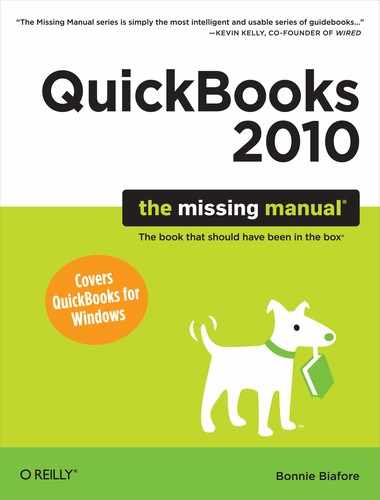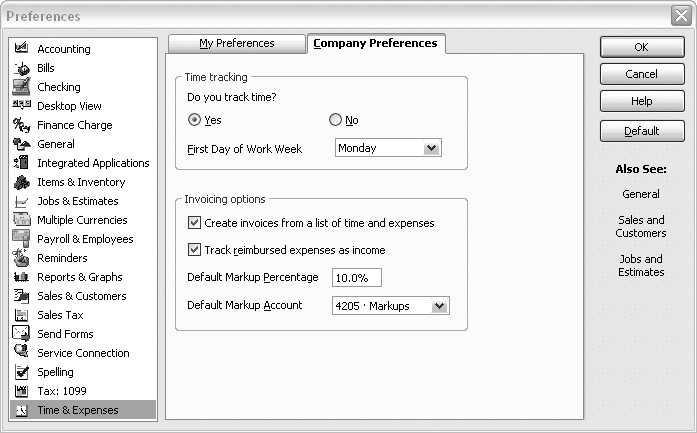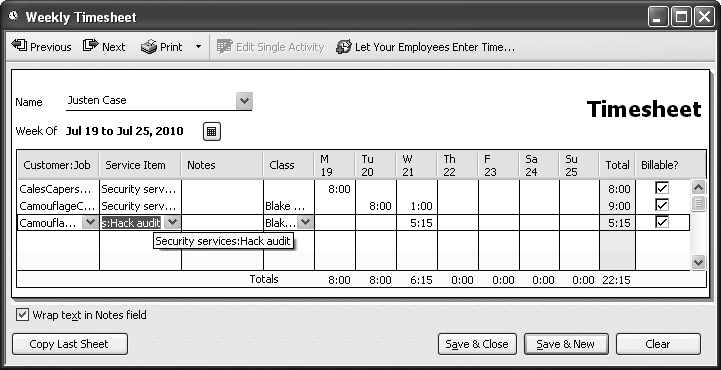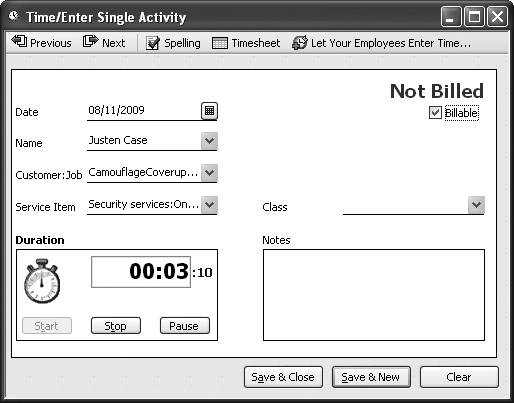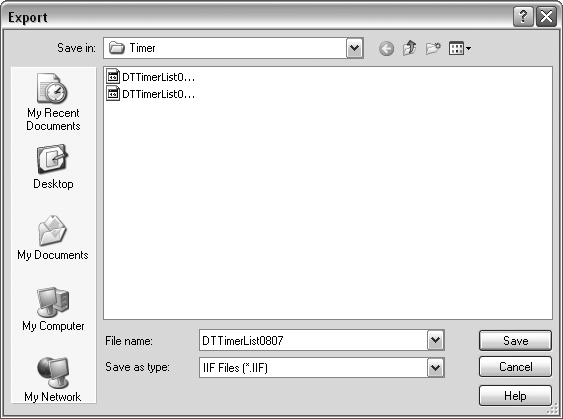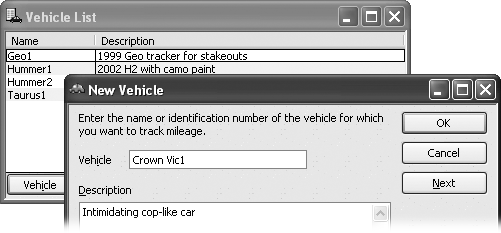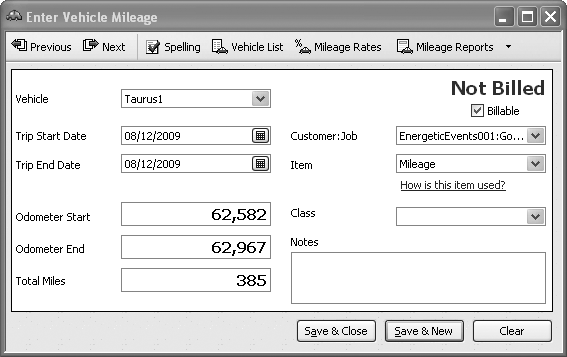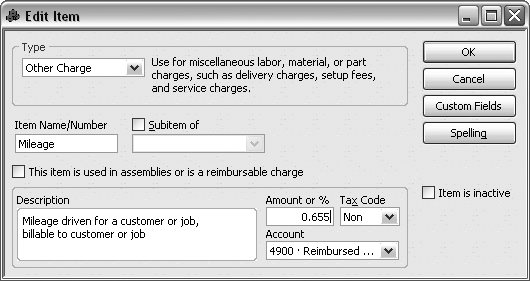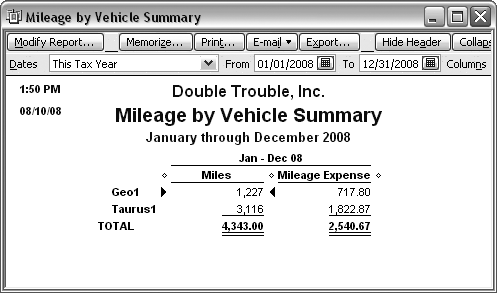Chapter 8. Tracking Time and Mileage
When customers pay for your services, they’re really buying your knowledge of how to get the job done the best and fastest possible way. That’s why a carpenter who can barely hit the nail on the head charges $15 an hour, whereas a master who hammers faster and straighter than a nail gun charges $80 an hour. When you come right down to it, time is money, so you want to keep track of both with equal accuracy. Product-based companies track time, too. For example, companies that want to increase productivity often start by tracking the time that employees work and what they work on.
There are hordes of off-the-shelf and homegrown time-tracking programs out there, but if your time tracking needs are fairly simple, you can record time directly in QuickBooks or use its companion Timer program, which you can provide to each person whose work hours you want to track. If you have to track the billable hours of lots of employees or contractors, Intuit has Time Tracker, a for-a-fee online timesheet service. The advantage of QuickBooks time tracking is that the time you record is ready to attach to an invoice (see Invoicing for Billable Time and Costs) or payroll (see Setting employee defaults). In this chapter, you’ll learn how to record time in QuickBooks itself and with the help of the online Time Tracker. Appendix D explains the ins and outs of the stand-alone Timer program.
Mileage is another commodity that many businesses track—or should. Whether your business hinges on driving or merely requires the occasional jaunt, the IRS lets you deduct vehicle mileage, but it requires documentation of the miles you deduct. The QuickBooks mileage tracking feature helps you track the mileage of company vehicles, which you can use not only for tax deductions, but to charge customers for mileage.
Setting Up Time Tracking
For many businesses, approximations of time worked are fine. For example, employees who work on only one or two tasks each day can review the past week and log their hours in a weekly timesheet. But for people with deliciously high hourly rates, you want to capture every minute you work on an activity from the time you start to the time you finish. QuickBooks can help you track time whether you take a conscientious approach or a more cavalier one. In fact, you can choose from three different ways to record time in QuickBooks:
Enter time data in QuickBooks. When QuickBooks is running, you can enter time for individual activities or in a weekly timesheet. If you enter time for a single activity, the Time/Enter Single Activity dialog box has a stopwatch of its own, so you can either time the task or simply type the number of hours.
Use Time Tracker and download online timesheets. Intuit’s online time tracking service lets people fill out timesheets online. You review the submitted timesheets online and download those timesheets into your company file. The box on Entering Time for One Activity tells you more.
Use the QuickBooks Timer stopwatch. This program, which comes free with QuickBooks, lets you time activities as you work so you can track your time to the second—as long as you remember to start and stop the Timer at the right moments. (If you forget to turn the Timer on or off, you can edit time entries to correct them.) The best thing about the Timer program is that you can record time without QuickBooks running. Moreover, you can give a copy of the Timer program to all your employees and subcontractors so they can send you time data to import into QuickBooks.
No matter which technique you use to capture time, the setup in QuickBooks is the same: You tell QuickBooks that you want to track time and then set up the people who have to track their time (employees and outside contractors alike). You use the customers and items you’ve set up in QuickBooks to identify the billable time you work. If you want to track nonbillable time, you need a few more entries in QuickBooks, which you’ll learn about in the following sections.
Turning on Time Tracking
If you created your company file with the QuickBooks EasyStep Interview (Company Information) and told QuickBooks that you want to track time, the preferences and features for time tracking should be ready to go. Only a QuickBooks administrator can turn time tracking on or off (which is why time tracking preferences are on the Company Preferences tab). You have to switch the company file to single-user mode (Switching Between Multi-User and Single-User Mode) to change Company preferences. To see if time tracking is turned on, choose Edit → Preferences. Click the Time & Expenses icon, and then click the Company Preferences tab, shown in Figure 8-1.
If the Yes option isn’t selected, click it. The only other time tracking preference is the first day of the work week. QuickBooks sets this preference to Monday to match the Monday through Friday work week of so many businesses. For round-the-clock services, self-employed people, and workaholics, choose whichever day of the week feels most like the beginning of the week. For example, many companies on a seven-day work week start the week on Sunday.
Setting Up the People Who Track Time
You can’t enter or import people’s time into QuickBooks unless their names appear in one of your name lists (Employee List, Vendor List, or Other Name List). If a person whose time you want to track doesn’t belong to a name list yet, here’s how you decide which list to use:
Employee List. Use this list only for the people you pay using QuickBooks’ payroll features.
Vendor List. Add subcontractors and outside consultants (people or companies that send you bills for time), whether or not their time is billable to customers. (Undoubtedly, their time is billable to you.)
Other Names List. By process of elimination, anyone who isn’t a vendor and isn’t paid via QuickBooks’ payroll belongs on the Other Names List. For example, employees paid using a third-party payroll service or owners who take a draw instead of a paycheck (Vendor Type List) qualify for this list.
People who track time directly in QuickBooks (with a weekly timesheet or in the Time/Enter Single Activity dialog box, not with the standalone Timer program) need the program’s permission to do so. When you set up QuickBooks users, you can set their permissions so they can enter time as described on What the Access Areas Represent.
Setting Up Items and Customers for Time Tracking
The good news is that your setup for what you bill time on is already done. The Service items (Service Items) and customer records (Creating a New Customer) you create for invoicing also work for tracking billable time. When you track time, you choose the Service item you’re working on. Then QuickBooks totals your hours and figures out how much to charge the customer based on the number of hours you worked and how much you charge per hour for the service.
The only time you need additional items is when you track all the hours that people work, both billable and nonbillable. For example, if you’re trying to reduce your overhead costs, you might add items to track the time spent fixing software bugs, exchanging bad products, and holding meetings. The level of detail for nonbillable activities is up to you, as shown in Figure 8-2.
Here is how you fill in item fields when you create items to track time that you don’t bill to a customer:
Type. Use the Service item type (Service Items) because that’s the only item type that QuickBooks time tracking recognizes.
Rate. In the New Item or Edit Item dialog box, the Rate box represents how much you charge your customers for the service. Because no money changes hands for nonbillable time, leave the Rate box blank.
Account. You can’t create an item without assigning it to an account. Go ahead and create an income account and call it something like Nonbillable Work or Overhead. If you number accounts, assign a number that places the account near the end of your Income type accounts (like 4997, because QuickBooks uses 5000 for the first Cost of Goods Sold account [Understanding the Profit & Loss Report]). Because nonbillable time doesn’t bring in any income, the account balance remains zero no matter how much nonbillable time you assign to it.
This service is performed by a subcontractor, owner, or partner. Leave this checkbox blank for nonbillable items performed by owners and partners. However, if a subcontractor performs nonbillable work, create a separate item for nonbillable time with this checkbox turned on. Then you can assign the subcontractor’s costs to an expense account and use time tracking to make sure the subcontractor’s bills are correct.
Entering Time in Timesheets
In QuickBooks, you can enter and view time for a single activity or through a weekly timesheet. If you record time after the fact, the weekly timesheet is the fastest way to enter time. If you already have one timesheet filled in, you can use it to speed up time entry, as the box below explains. To time work as you perform it, the Time/Enter Single Activity dialog box (explained in the section that begins on Entering Time for One Activity) is the place to go.
Filling in Weekly Timesheets
The weekly timesheet is the fastest way to enter time for several activities or work that spans several days:
Choose Employees → Enter Time → Use Weekly Timesheet.
QuickBooks opens the Weekly Timesheet dialog box.
Note
Although you can track time for people other than employees, you still access time tracking from the Employees menu or the Employee Center. To open the Weekly Timesheet window from the Employee Center, on the Home page, click Employees. Then, in the Employee Center’s menu bar, choose Enter Time → Use Weekly Timesheet.
In the Name drop-down list, choose the name of the person who performed the work.
Because time tracking is rarely limited to only the people with permission to run QuickBooks, you can enter time for yourself or anyone else. After you choose a name, the program displays the weekly timesheet for the current week and shows any time already entered for the week, as shown in Figure 8-3.
If you want to enter time for a different week, in the window toolbar, click Previous or Next until the week you want appears.
To choose a week further in the past, click the calendar icon to the right of the week’s date range. In the Set Date window that appears, click the arrows to the left or right of the month heading to move to a past or future month. Click any date during the week to choose that work week. For example, choosing 22 in the July 2010 calendar switches the weekly timesheet to the week beginning July 19, 2010.
To add a billable activity to the timesheet, in the first blank Customer:Job cell (the first column of the timesheet table), choose the customer or job associated with the work performed.
If the work is billable, choose the customer or job that pays for it. If the time isn’t billable, you can leave the customer field blank. Depending on whether you keep your hands on the keyboard or the mouse, you can move to the Service Item cell by pressing Tab or clicking the Service Item cell.
In the Service Item cell, choose the item that represents the work the person performed.
If you use QuickBooks payroll and pay employees by the hours they work, you fill in the Service Item and the Payroll Item. The Payroll Item column appears to the right of the Service Item column. In the Payroll Item column, you can choose the payroll-related item (Setting Up Compensation and Benefits) that applies to the time worked. For example, for billable work, choose a payroll item such as Salary or Employee Income. If the hours are for vacation or sick time, choose the payroll item you’ve created for that time.
In the Notes cell, type additional information about the work.
For example, if someone receives comp time but your company doesn’t formally track it, you might use a Service Item such as Administrative and use the Notes cell to identify the comp time taken. If your customers require detail about the work performed, store that information in the Notes cell, which then appears on the invoices you create (see Selecting Billable Time and Costs).
If you use classes to track income (Understanding customer types), in the Class column, choose one for the work.
For example, if you track income by partner, choose the class for the partner who handles the customer. If you use classes to track office branches, choose the class for the branch where the person works.
To enter time for a day during the week, click the cell for that day or press Tab until you reach the right day.
You can enter time in several ways. If you know the number of hours, type the hours as a decimal or as hours and minutes. For example, for seven and a half hours, type either 7.5 or 7:30. QuickBooks displays the hours in the timesheet based on the preference you set for time (Company-Wide General Preferences). If you know the starting and ending time, QuickBooks can calculate the hours for you. For example, if you type 9-5 in a cell, the program transforms it into eight hours when you move away from the cell (by pressing Tab or clicking another cell).
As you enter time for each day of the week, the Total column on the right side of the table shows the total hours for each activity. The numbers in the Totals row below the table show the total hours for each day and for the entire week.
If you aren’t billing the customer for the work, in the Billable? column, click the checkmark to turn it off.
QuickBooks adds a checkmark to the Billable? column automatically. When you click the billable cell, the checkmark disappears to indicate that the time isn’t billable.
Note
Adding billable time to customer invoices is easy, as described in detail on Selecting Billable Time and Costs.
To save the timesheet, click Save & Close or Save & New.
If you enter time for a number of people, click Save & New to save the current weekly timesheet and open a new blank one. Clicking Save & Close saves the timesheet and closes the weekly timesheet dialog box.
Entering Time for One Activity
Entering time in a weekly timesheet is quick, but the width of the columns makes it hard to see which customer and service item you’re tracking. If you prefer readability to speed, the Time/Enter Single Activity window is a better choice. The Time/Enter Single Activity window also lets you start and stop a stopwatch if you want to time work as you go.
You have to fill in every field for every activity in the Time/Enter Single Activity window. If you grow tired of this form of time entry, in the window’s toolbar, click Timesheet to switch to the Weekly Timesheet window. The weekly timesheet that appears is for the person you selected in the Time/Enter Single Activity window and the week that includes the selected day.
Here’s how you enter time for one activity at a time:
Choose Employees → Enter Time → Time/Enter Single Activity.
The Time/Enter Single Activity window opens to today’s date.
If the person with time to report is an employee, you can get QuickBooks to fill in the Name box automatically. On the Home page, click Employees to open the Employee Center. On the Employees tab, select the employee whose time you want to enter and then, in the Employee Center’s menu bar, choose Enter Time → Time/Enter Single Activity.
If you want to record time for another day, in the Date field, click the Calendar icon and choose the date on which the work took place.
When you first open the Time/Enter Single Activity window, QuickBooks selects all the text in the Date box. You can replace the date by simply typing the new date, like 6/07/10.
In the Name drop-down list, choose the name of the person who performed the work.
The Name drop-down list includes vendors, employees, and names from the Other Names List. If you choose an employee who isn’t set up for sending time data to payroll, QuickBooks asks whether you want to change the employee’s setup (Creating employee records). If you want to use the time entered to generate paycheck data—for instance, when employees are paid by the hour—click Yes, which links the employee’s time records to paycheck data.
Note
When you first open the Time/Enter Single Activity window you may see the Payroll Item label. If you set up employees so that their time data generates the values on their paychecks (Setting employee defaults), you can select the payroll item to which the time applies. However, if you choose the name of a person who isn’t paid based on their time, the Payroll Item entry disappears. If you use classes, the Class entry takes its place.
In the Customer:Job drop-down list, choose a customer or job.
If someone performs work for a real customer or job, choose that customer or job whether or not you bill the time. To track overhead time, choose the customer you created for nonbillable work.
If the hours aren’t billable to a customer, turn off the Billable checkbox.
The Billable checkbox isn’t the next field that QuickBooks chooses if you press Tab; it’s located in the upper-right corner of the window. But choosing a customer is a reminder for whether the hours are billable. QuickBooks automatically turns on the Billable checkbox, so you have to worry about this checkbox only if the hours aren’t billable.
In the Service Item drop-down list, choose the item that represents the work performed.
Choose this item whether it’s one you use to invoice customers or a nonbillable item you created to track overhead activities.
Press Tab to move to the Duration box. QuickBooks automatically selects the contents of the box, so you can simply type the hours worked. If you click the Duration box, drag to select its contents.
Type hours as a decimal or as hours and minutes, such as 5.5 or 5:30. Or, if you know the starting and ending time, type the time range to have QuickBooks calculate the hours. For example, if you type 11-5 in a cell, the program fills in the box with 6:00 when you tab or click away from the box.
If you work in QuickBooks almost all the time, you can time a task that you’re working on in the Time/Enter Single Activity window, as shown in Figure 8-4.
Figure 8-4. To time your current activity, the Date field has to have today’s date. To start the stopwatch, click Start. You’ll see the seconds that are passing to the right of the Duration box to show that it’s timing your work. If you want to pause the stopwatch to take a break or a phone call, click Pause; simply click Start to start timing again. When you finish the task, click Stop. (Unless you have special time-travel powers, you can’t run a stopwatch for work performed on a different day.)If you track classes, in the Class field, choose the appropriate one. To add notes about the activity, type text in the Notes box.
These notes appear in the Notes column in the Weekly Timesheet dialog box and, for billable work, appear on invoices you generate from time worked.
To save the transaction, click Save & New or Save & Close.
When you click Save & New, the saved activity represents time for only one day. To record time for another day’s work even if it’s for the same worker, customer, and Service item, you have to create a new activity.
Running Time Reports
Customers don’t like being charged for too many hours, and workers are quick to complain if they’re paid for too few. Before you use time records either for billing customers or feeding your payroll records, it’s a good idea to generate time reports to make sure your time data is correct. (The box below explains how to set up employees in QuickBooks so their reported time links to your QuickBooks payroll.)
To generate a time report in QuickBooks, choose Reports → Jobs, Time & Mileage, and then choose the report you want. Here are the reports you can choose from and what they’re useful for:
Time by Job Summary. If you bill by the job, the “Time by Job Summary” report shows hours by customer or job, broken down by Service items. Overly high or low hours—or Service items that don’t belong on a job—are red flags for data entry errors. Review the total hours worked on a job during a period. Because of the high-level view in this report, it’s perfect for spotting time charged to inappropriate Service items or hours that exceed job limits. If hours seem too high or low, you can drill down with the “Time by Job Detail” report to investigate.
Time by Job Detail. If you want to verify that hours were correctly set as billable or nonbillable, use this report. It’s grouped by job and Service item, but each time entry shows the date the hours were worked, who performed the work, and whether the work is billable (the Billing status is Unbilled for billable hours not yet invoiced, Billable for invoiced billable hours, or Not Billable).
Time by Name. This report shows the hours worked by person, with the hours worked for each customer or job, as shown in Figure 8-5. QuickBooks sets the date range to This Fiscal Year-to-Date, but if you want to check timesheets for accuracy, you can change the date range to Last Week or Last Month. If a person reports too many or too few hours for a period, use the Weekly Timesheet dialog box to look for signs of inaccurate or missing time reports.
Time by Item. This report groups hours by Service item and then by customer or job. You can use this report to analyze where your billable and nonbillable time is spent, either to cut unproductive activities or to determine staffing needs.
Tracking Mileage
If you charge your customers for mileage, keeping track of the billable miles you drive helps you get all the reimbursements you’re due. But all business-related mileage is tax-deductible, so tracking nonbillable business mileage is important, too. Customers and the IRS alike want records of the miles you drive, and QuickBooks can help you produce that documentation.
The mileage tracking feature in QuickBooks tracks only the miles you drive using company vehicles, not other vehicle expenses, such as fuel or tolls. Likewise, you don’t use QuickBooks mileage tracking to record miles driven by employees, vendors, or subcontractors, which instead go straight to an expense account. For example, if a vendor bills you for mileage, when you enter the bill in QuickBooks (Entering Bills), you assign that charge to an expense account, such as Travel-Mileage. When you write a check to reimburse an employee for mileage driven, you assign that employee reimbursement to the expense account for mileage.
Adding a Vehicle
To track mileage for a company vehicle, you first have to add the vehicle to the QuickBooks Vehicle List. Here’s how:
To open the Vehicle List window, choose Lists → Customer & Vendor Profile Lists → Vehicle List.
The Vehicle List window opens.
To add a new vehicle, press Ctrl+N or click Vehicle and then choose New from the drop-down menu.
The New Vehicle dialog box opens, as shown in Figure 8-6.
In the Vehicle box, type a name for the vehicle.
To easily identify your company cars and trucks, include the type of vehicle and a way to differentiate it from others. For instance, if your company cars are all white Jeeps, the license plate number is a better method of identification than make and color.
In the Description box, type additional information such as the year, make, model, license plate number, or Vehicle Identification Number (VIN).
To change vehicle information later, in the Vehicle List window, double-click the vehicle name, and then, in the Edit Vehicle dialog box, edit the name or description.
Click OK.
That’s it. The name and description appear in the Vehicle List window.
Setting the Mileage Rate
For tax purposes, you can deduct mileage expenses based on a standard mileage rate or by tracking the actual costs of operating and maintaining your vehicles. Using a standard mileage rate is convenient—simply multiply the miles you drove by the standard rate to calculate your vehicle deduction.
If you own an expensive car with expensive maintenance needs, actual costs might provide a larger deduction. But you have to keep track of what you spend on gas, tires, repairs, insurance, and so on, and deduct those costs on your tax return. As usual, the tax rules for deducting operating and maintenance costs are, well, taxing. Before you choose this approach, ask your accountant or the IRS if you can deduct actual costs and whether it’s the best approach.
QuickBooks stores multiple mileage rates along with their effective dates, because standard mileage rates usually change at the beginning of each calendar year. To set a mileage rate, first open the Enter Vehicle Mileage window (choose Company → Enter Vehicle Mileage). Then, in the dialog box’s tool bar, click Mileage Rates, which opens the Mileage Rates window shown in Figure 8-7.
Recording Mileage Driven
Once you’ve added a vehicle to the Vehicle List, you’re ready to record mileage. (You don’t have to set the mileage rates to record the miles you drive, but you’ll need that rate in place before you bill a customer for mileage.) Here’s how you fill in the Enter Vehicle Mileage window to record billable and nonbillable miles you’ve driven:
Open the Enter Vehicle Mileage window (choose Company → Enter Vehicle Mileage). In the Vehicle box, choose the vehicle that you drove.
If you forgot to add the vehicle to the list, you can create it now by choosing <Add New> from the drop-down menu.
In the Trip Start Date box and the Trip End Date box, choose the days you started and completed the trip, respectively.
If you’re recording mileage for one day of onsite work, choose the same day in both boxes. On the other hand, if you used a company car to drive to another city for several days, the Trip Start Date is the day you headed out of town and the Trip End Date is the day you returned.
In the Odometer Start box and Odometer End box, type the vehicle mileage before you began driving and the mileage when you returned, as shown in Figure 8-8.
QuickBooks automatically calculates the miles you drove and plops that number in the Total Miles box.
Figure 8-8. From the Enter Vehicle Mileage toolbar, you can generate reports of the mileage you’ve driven. Click Mileage Reports (Generating Mileage Reports).If you usually forget to check the starting mileage, you can ignore the Odometer Start and Odometer End boxes entirely. Instead, in the Total Miles box, type the mileage you drove. For example, if you know that a round-trip to your customer is 72 miles, in the Total Miles box, just type 72. You can type the mileage with or without commas (1,500 or 1500).
The drawback to this approach is that your mileage record doesn’t include the odometer readings that the IRS wants to see. But if every mile you drive is for business, you can prove your deduction by showing the IRS an odometer reading at the beginning of the year and one at the end of the year.
If your mileage is billable to a customer or job, turn on the Billable checkbox. Then, in the Customer:Job box, choose the customer or job to whom you want to assign the mileage. In the Item drop-down list, choose the item you created for mileage.
If the mileage isn’t billable to a customer, choose the faux customer you created to track time spent on administrative activities (Setting Up Items and Customers for Time Tracking). For tips on creating an item for mileage, see the box below.
If you track classes, in the Class box, choose the appropriate one.
For example, if you use classes to track branch performance, choose the class for the branch. However, if you track partner income with classes and the mileage is nonbillable, you don’t need a class assignment.
To further document the reason for the mileage, type text in the Notes box. Then, to save the mileage and close the dialog box, click Save & Close.
If you want to enter additional mileage for other customers and jobs, click Save & New.
Generating Mileage Reports
Mileage records come in handy when you prepare your taxes or if your customers question their mileage charges. The reports are simple, mainly because you don’t track that much mileage information. You can generate mileage reports by choosing Reports → Jobs, Time & Mileage and then choosing the report. To generate a report, in the Enter Vehicle Mileage window’s toolbar, click the down arrow to the right of the Mileage Reports command.
Here are the reports you can choose and what they’re useful for:
Mileage by Vehicle Summary. For your tax backup, this report shows the total miles you drove each vehicle and the corresponding mileage expense (which QuickBooks calculates using the standard mileage rate in effect at the time). The date range is set initially to This Tax Year, which is perfect for generating the data you need for your tax return, as shown in Figure 8-10.
Mileage by Vehicle Detail. This report shows each trip that contributed to a vehicle’s mileage. For each trip made, the report includes the trip end date, total trip miles, mileage rate, and mileage expense. If you have questions about your deductions, double-click a trip entry to open the Enter Vehicle Mileage window for that transaction.
Mileage by Job Summary. If you charge customers for mileage, run this report both for total miles driven and the billable mileage by customer and job.
Mileage by Job Detail. If a customer has a question about mileage charged, this report is the quickest way to find the charges in question. The report groups mileage by customer or job, but lists each trip in its own line. The report shows the trip start date, trip end date, miles driven, billing status, mileage rate, and billable amount, so you can answer almost any mileage-related question a customer might have.
